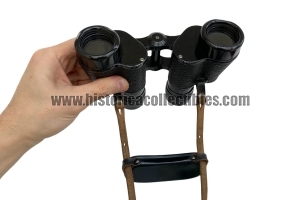Binoculars 8x30, San Giorgio Genova-Sestri, Royal Italian Air Force, circa 1940
Binoculars 8x30, produced by San Giorgio Genova-Sestri in around 1935, to be destined for the Royal Air Force.
On the left eyepiece plate there are the manufacturer's mark "San Giorgio Genova-Sestri" and the magnifications "8x30".
On the right eyepiece plate is the military acceptance mark "R. Aeronautica Italiana" (Royal Italian Air Force). The numbered graticule for calculating distances is located in the right eyepiece.
They are very light binoculars, built entirely in aeronautical aluminium, which gives them extreme resistance and lightness.
The binoculars are in excellent condition and come complete with a case marked with the S.G. logo, a benutzer and shoulder straps.
The binoculars are collimated and all mechanisms work perfectly for optimal viewing.
History of San Giorgio:
The San Giorgio – Genova company was founded in 1905 in Genova Sestri Ponente as San Giorgio, an anonymous company for the construction of land and sea automobiles. The automotive industry is in its infancy in Italy and attracts the interest of several entrepreneurs. Attilio Odero, owner of an important shipyard and majority shareholder of Terni, participated in the establishment of the new Genoese company, while Arturo Bocciardo has been its CEO since 1907.
Precisely in that year, coinciding with a crisis (of growth) in the car sector, San Giorgio abandoned this production to focus on the repair and construction of railway carriages (in the Pistoia workshop) and on various mechanical works in Genova, where the production of electrical equipment for ships began in 1911-1912. The orders from the Navy are important, guaranteeing work for the workshops.
The First World War brought about strong growth for the company, which specialized in the production of rangefinders and aiming instruments for artillery. Taking advantage of the disappearance of fierce German competitors from the Italian market, San Giorgio acquired considerable technological knowledge; its workers stand out for their high professionalism.
After the conflict it was necessary to carry out the conversion from war work to civilian production: San Giorgio carried out this successfully, then taking over, in 1923, the electromechanical workshops of Rivarolo (Genova) from the Piaggio group, which became a shareholder of San Giorgio.
In the 1920s, production was qualified and diversified: machinery for power plants, optical and measuring instruments left the company's factories. This represents a strength but also a weakness for the company, which is not able to achieve the appropriate economies of scale. The effects of the 1929 crisis also affected San Giorgio: although it did not end up under direct public control, since 1934 the company had IRI among its shareholders, alongside private Genoese entrepreneurs. In the second half of the 1930s military production resumed and with them the growth of the company: in 1937 there were 5,100 employees, in 1942 their number rose to 12,000.
War has catastrophic outcomes; in June 1944, 700 Genoese workers were deported by the Germans to Germany.




